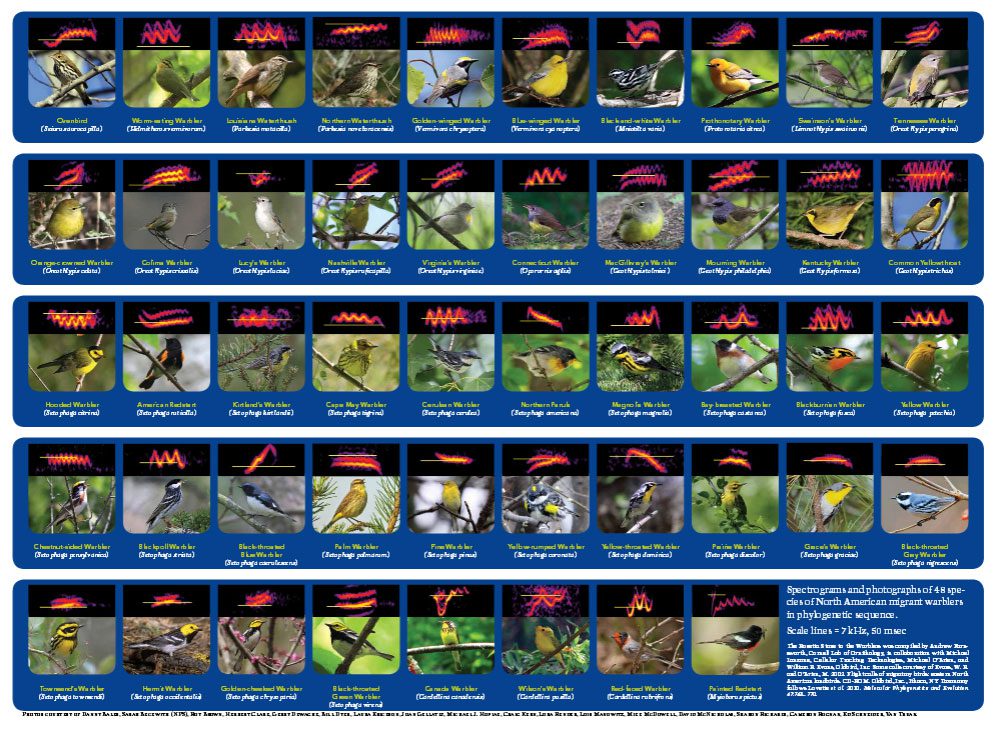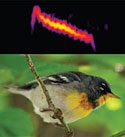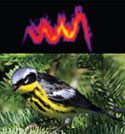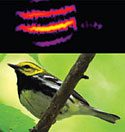A Rosetta Stone for Identifying Warblers’ Migration Calls
April 15, 2011These spectrograms are a visual representation of the very brief flight calls made by North American warblers during their nocturnal migrations. Some of these call notes sound almost identical to our ears, but spectrograms show minute differences between them. Scientists can compare spectrograms of night recordings to spectrograms of known species to identify nocturnal migrants in total darkness. Andrew Farnsworth, a scientist in the Cornell Lab’s Conservation Science program, developed this “Rosetta Stone” in 2006 in collaboration with Michael Lanzone, Cellular Tracking Technologies, William R. Evans, and Michael O’Brien. It covers all 48 warbler species of the U.S. and Canada (including Grace’s and Red-faced warblers, not shown), and is a major tool in our Acoustic Monitoring Project.
Putting Sound to Work for Conservation
It’s been an exciting year for sound-analysis teams at the Cornell Lab. A recent gift from the Kenneth L. Harder Trust will help our Acoustic Monitoring Project make automated acoustic analysis a reality. As sound recordings continue to pour in from studies conducted around the world, computers become essential to the problem of analyzing all the data they contain.
Our staff will use results from the Rosetta Stone and funding from the Harder gift to “train” computers to identify the sounds of warblers and other nocturnally migrating birds as well as other species including whales and forest elephants.
“Acoustic monitoring generates terabytes of data to manage and analyze,” says Paul Allen, AMP project leader. “The infrastructure and tools developed and integrated by AMP will expand our capacity for monitoring, which is increasingly in demand, and extend our ability to automatically classify what species created the sound.”
The $1.25 million gift comes from trustee Scott Harder, Karen (Tillman) Harder ’81, Liv Harder ’11, and Donald Harder. Kenneth Harder, Scott’s uncle, was a lifelong birder, and the Harders are longtime supporters of the Cornell Lab.
Working Toward a Bird Migration Forecast
A new grant from the National Science Foundation, for $2.2 million, will fund BirdCast, a project that will combine bird observations (both sightings and sound recordings) with weather models and terrain data to forecast migrations. The results of the predictions will help scientists understand migratory behavior and may aid decisions about wind turbine placement and other questions about environmental hazards to birds.
We thank the Kenneth L. Harder Trust, National Science Foundation, and members of the Cornell Lab of Ornithology for supporting our ongoing efforts to develop powerful acoustic techniques to advance the understanding of migration, one of nature’s most complex phenomena.
Learn more about BirdCast and the Acoustic Monitoring Project in this Cornell Chronicle article.
Originally published in the Spring 2011 issue of BirdScope.

All About Birds
is a free resource
Available for everyone,
funded by donors like you
American Kestrel by Blair Dudeck / Macaulay Library




